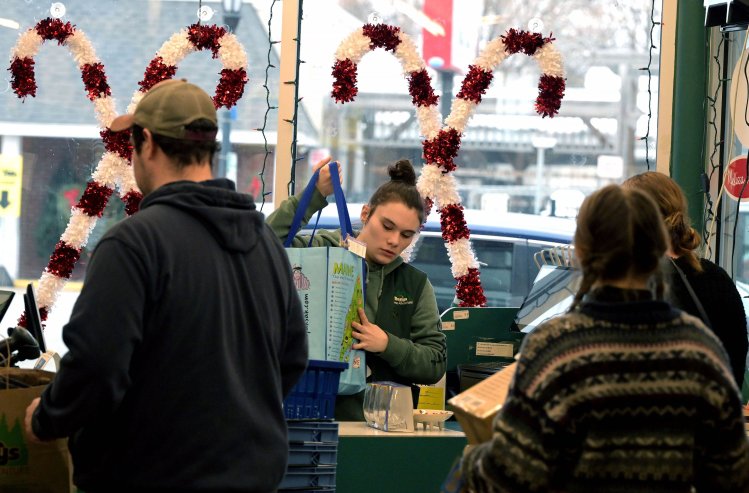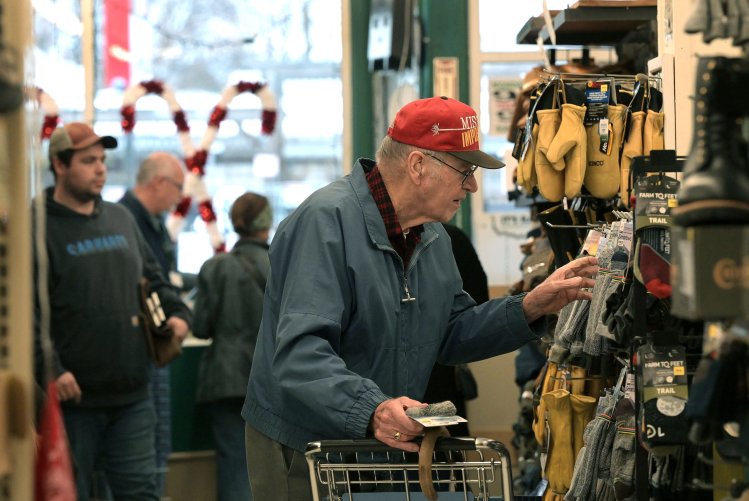
After years of enduring worker shortages, Maine retailers say they are having an easier time hiring people to keep up with holiday-season demand. Sales of items like clothing, electronics, home goods and toys this winter are expected to reach almost $1 trillion nationally, up slightly from 2023.
“We saw a pretty good improvement last year,” said Curtis Picard, president and chief executive officer of the Retail Association of Maine. “My sense is hiring has gotten better.”
But with the latest unemployment rate of 2.9%, considerably below the 4.2% U.S. rate, employers face tough competition for hiring. To attract workers, employers are offering shorter hours and flexible scheduling, he said. They’re also hiring high school and college students who want to earn some money and learn to work with customers.
Will McDowell, 18, was working his first day Wednesday at Renys in Windham. The American history student at Lawrence University in Appleton, Wisconsin, was looking for a job and his parents suggested the department store. He’s taking advantage of a school break extending from before Thanksgiving to Jan. 5.
“I can feel productive,” said McDowell, a North Yarmouth resident. “I would never see this many people on any given day.”
The $16 an hour job, or $640 a week full-time before taxes, will pay for groceries when he goes back to college, McDowell said.
Jason Sulham, spokesman for L.L.Bean, said the Freeport-based outdoor clothing and equipment retailer is on track for its hiring goal of about 3,500 “peak season hires” due to an “excellent rehire rate.” That’s slightly less than half the number during non-peak season, he said.
“Like most businesses, we experienced some challenges this year due to the low-employment rate,” he said.

Still, a “fluctuating retail landscape” is forcing the company to lay off up to 75 employees at its corporate headquarters in March, according to Sulham.
Holly Margaritis, human resources coordinator at Renys, said the chain of 18 department stores across Maine is always hiring for the holidays. “We ramp up for the additional customers,” she said.
“In larger cities it’s easier to pull from. There’s a larger pool,” Margaritis said.
The company usually has about 490 workers at its stores, administrative offices and warehouse. The number rises to 560 at Christmas and during the summer, Margaritis said. Youngsters who work in the summer return to Renys for the holidays, she said.
The employees are quickly trained to work the cash register where they learn to handle money and face customers. Norm Robert, manager of the Windham Renys, says the goal is to “get the customer in and out of the store. Customers don’t want to wait.”
Glenn Mills, deputy director of the Center for Workforce Research at the state Department of Labor, said Maine’s retail industry has settled into an employment pattern that has prevailed for years: a spike in hiring in the run-up to the summer tourism season and again for Christmas shopping, and a leveling off during the other months.
The rise of online shopping has kept a lid on retail employment. The number of retail jobs in Maine has consistently been in the “low 80,000s, 70,000s,” he said. It’s not changed much even though Maine’s population has grown, he said.
Retail employment is flat and is dwindling as a share of overall employment, Mills said. “It’s amazing it’s held up as well as it has.”
Nationally, a strong economy is helping boost strong holiday sales that justify hiring.
On a conference call in mid-October, Matthew Shay, president and chief executive officer of the National Retail Federation, said that “overall, the economy has been in a good place this year.”
Retail represents 70% of economic activity, and holiday sales are projected to rise between 2.5% and 3.5% over 2023, to as much as $989 billion, according to the retail group. It compares with $955.6 billion last year. The industry group said it expects retailers will hire between 400,000 and 500,000 seasonal workers, which “tracks very much in line with hiring patterns of 2023,” Shay said.
Retailers are well staffed now and have already been adding workers so the “same kind of spike” in previous holiday hiring sprees may not materialize, he said.
Whether the healthy increase in sales “translates into job hiring is more uncertain than normal,” said Andy Challenger, senior vice president at Challenger, Gray & Christmas Inc., an outplacement and career consulting firm.
“We don’t know what employers are going to do,” he said.
Labor shortages following the COVID-19 pandemic are over. “I’m not hearing about major staffing issues,” he said.
“It was the greatest labor shortage in modern history. It’s been slowly cooling,” Challenger said.

We invite you to add your comments. We encourage a thoughtful exchange of ideas and information on this website. By joining the conversation, you are agreeing to our commenting policy and terms of use. More information is found on our FAQs. You can modify your screen name here.
Comments are managed by our staff during regular business hours Monday through Friday as well as limited hours on Saturday and Sunday. Comments held for moderation outside of those hours may take longer to approve.
Join the Conversation
Please sign into your CentralMaine.com account to participate in conversations below. If you do not have an account, you can register or subscribe. Questions? Please see our FAQs.